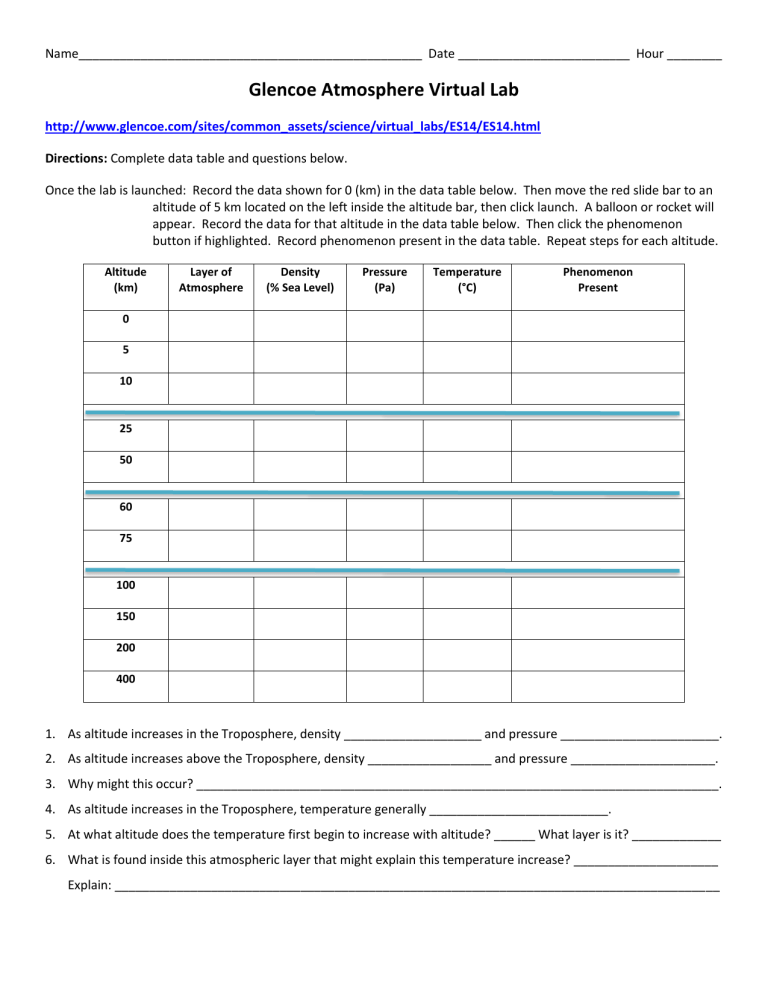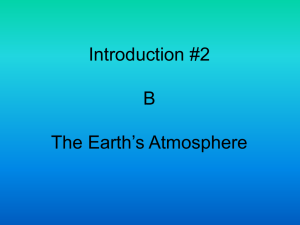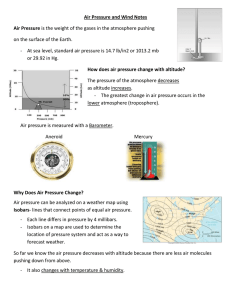Atmosphere Virtual Lab-Density and Air Pressure
advertisement

Name__________________________________________________ Date _________________________ Hour ________ Glencoe Atmosphere Virtual Lab http://www.glencoe.com/sites/common_assets/science/virtual_labs/ES14/ES14.html Directions: Complete data table and questions below. Once the lab is launched: Record the data shown for 0 (km) in the data table below. Then move the red slide bar to an altitude of 5 km located on the left inside the altitude bar, then click launch. A balloon or rocket will appear. Record the data for that altitude in the data table below. Then click the phenomenon button if highlighted. Record phenomenon present in the data table. Repeat steps for each altitude. Altitude (km) Layer of Atmosphere Density (% Sea Level) Pressure (Pa) Temperature (°C) Phenomenon Present 0 5 10 25 50 60 75 100 150 200 400 1. As altitude increases in the Troposphere, density ____________________ and pressure _______________________. 2. As altitude increases above the Troposphere, density __________________ and pressure _____________________. 3. Why might this occur? ____________________________________________________________________________. 4. As altitude increases in the Troposphere, temperature generally __________________________. 5. At what altitude does the temperature first begin to increase with altitude? ______ What layer is it? _____________ 6. What is found inside this atmospheric layer that might explain this temperature increase? _____________________ Explain: ________________________________________________________________________________________ Temperature and Altitude Graph Directions The data from the virtual lab is just a sampling of how temperature changes as altitude increases. To better understand how temperature changes and why, in each of the layers of the atmosphere, use the data chart in Table 1 below to create a line graph on the graph provided (next page). Then answer the analysis questions. Steps to Complete: 1. Plot your data points: When constructing a line graph, data points (dots) are plotted on a graph then connected by together by a line. To plot a data point, find the altitude on the y axis. Then go over from that point to the temperature indicated and draw a dot. Do the same for each set of data provided. The first 3 data points are plotted for you. 2. Connect all data plots with a red colored pencil: When you have plotted all data points, connect the dots by starting at the first point plotted ( 0 altitude, 15 °C ). Connect all data points in the order listed in Table 1. 3. Label each of the four primary layers of the atmosphere. Horizontal lines indicate where each layer ends and begins. The exosphere is labeled for you 4. Locate, shade in and label the Ozone Layer: The most concentrated part of the ozone layer extends from about 20 km to 35 km. Lightly shade this area yellow on the line graph. Color lightly enough so data points are visible. 5. Read page 410 Composition of the Atmosphere. List the 3 types/categories of particles which make up our atmosphere: ___________________________, ____________________________ and ____________________. 6. Complete Gases of the Atmosphere Circle Graph: Label and color the pie graph as follows: Nitrogen (green) Oxygen (blue) Trace gases (orange). List the trace gases next to their symbols in the box below. Trace Gases Include: 1. __________________ (H2O) (0-4%) 2. __________________ (CO2 ) (0.38%) 3. __________________ (O3) 4. __________________ (Ar) Average Temperatures at Various Altitudes Exosphere 600 0 500 0 400 0 300 0 200 0 Altitude (km) 100 0 90 0 80 0 70 0 60 0 50 0 40 0 30 0 20 0 10 0 0 0-100 -90 -80 Analysis Questions: -70 -60 -50 -40 -30 -20 -10 0 10 20 500 1000 Temperature (° C) 1. What pattern change do you notice where each layer of the atmosphere is labeled? _____________________ __________________________________________________________________________________________ 2. Within the Troposphere, as altitude increases, temperature ______________________________. 3. At what altitude and layer does the temperature begin to increase with altitude? ______ /_________________ 4. What is present in this layer at this altitude that might explain this increase? ____________________________ 5. Explain why the presence of ozone vs oxygen can cause an increase in temperature (pg. 412) _______________ ___________________________________________________________________________________________ (Page 414) Key Concept How does air pressure and temperature change as altitude increases? Directions: On each line, write the term from the word bank that correctly completes each sentence. Some terms may be used more than once. air pressure density exosphere gravity mesosphere Ozone layer stratosphere thermosphere troposphere energy 1. The force that pulls the atmosphere toward Earth is . 2. The downward pull gravity exerts on a column of air is called ______________________________. 3. The more gas molecules that are in a given volume of air, the greater the_____________ of the air will be. 4. In the_______________________ and the ____________________, temperature decreases as altitude increases. 5. In the _______________________and the ______________________, just the opposite occurs, where temperature increases as altitude increases. 6. Temperature increases with altitude in this layer (the ___________________________) because of the presence of the _____________________________, which absorbs solar radiation and protects us from harmful ultra violet radiation from the Sun. 7. Temperatures also increase in the _______________________ because these layers receive large amounts of ___________________ from the Sun which is spread across very few molecules. Figure 1 8. Look at the Figure 1 to the left. Which layer of the atmosphere will exert the most air pressure? _______________________ Explain/justify your answer: ___________________________ ___________________________________________________ ___________________________________________________ 9. Which layer of the atmosphere will exert the least air pressure? ______________________________________________ Explain/justify your answer: __________________________ __________________________________________________ __________________________________________________




